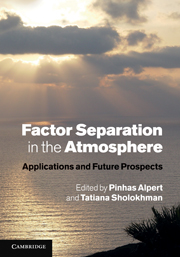Refine search
Actions for selected content:
2584 results in Computational Science
References
-
- Book:
- Greedy Approximation
- Published online:
- 05 August 2012
- Print publication:
- 08 September 2011, pp 405-414
-
- Chapter
- Export citation
Contents
-
- Book:
- Greedy Approximation
- Published online:
- 05 August 2012
- Print publication:
- 08 September 2011, pp v-viii
-
- Chapter
- Export citation
4 - Approximation in learning theory
-
- Book:
- Greedy Approximation
- Published online:
- 05 August 2012
- Print publication:
- 08 September 2011, pp 183-276
-
- Chapter
- Export citation
3 - Entropy
-
- Book:
- Greedy Approximation
- Published online:
- 05 August 2012
- Print publication:
- 08 September 2011, pp 143-182
-
- Chapter
- Export citation
5 - Approximation in compressed sensing
-
- Book:
- Greedy Approximation
- Published online:
- 05 August 2012
- Print publication:
- 08 September 2011, pp 277-333
-
- Chapter
- Export citation
6 - Greedy approximation with respect to dictionaries: Banach spaces
-
- Book:
- Greedy Approximation
- Published online:
- 05 August 2012
- Print publication:
- 08 September 2011, pp 334-404
-
- Chapter
- Export citation
Frontmatter
-
- Book:
- Greedy Approximation
- Published online:
- 05 August 2012
- Print publication:
- 08 September 2011, pp i-iv
-
- Chapter
- Export citation
Index
-
- Book:
- Greedy Approximation
- Published online:
- 05 August 2012
- Print publication:
- 08 September 2011, pp 415-418
-
- Chapter
- Export citation
2 - Greedy approximation with respect to dictionaries: Hilbert spaces
-
- Book:
- Greedy Approximation
- Published online:
- 05 August 2012
- Print publication:
- 08 September 2011, pp 77-142
-
- Chapter
- Export citation
1 - Greedy approximation with regard to bases
-
- Book:
- Greedy Approximation
- Published online:
- 05 August 2012
- Print publication:
- 08 September 2011, pp 1-76
-
- Chapter
- Export citation
A note on the triple product property for subsets of finite groups
- Part of
-
- Journal:
- LMS Journal of Computation and Mathematics / Volume 14 / 2011
- Published online by Cambridge University Press:
- 01 September 2011, pp. 232-237
-
- Article
-
- You have access
- Export citation
Families of explicitly isogenous Jacobians of variable-separated curves
- Part of
-
- Journal:
- LMS Journal of Computation and Mathematics / Volume 14 / 2011
- Published online by Cambridge University Press:
- 01 August 2011, pp. 179-199
-
- Article
-
- You have access
- Export citation
Searching for small simple automorphic loops
- Part of
-
- Journal:
- LMS Journal of Computation and Mathematics / Volume 14 / 2011
- Published online by Cambridge University Press:
- 01 August 2011, pp. 200-213
-
- Article
-
- You have access
- Export citation
Computations with classical and p-adic modular forms
- Part of
-
- Journal:
- LMS Journal of Computation and Mathematics / Volume 14 / 2011
- Published online by Cambridge University Press:
- 01 August 2011, pp. 214-231
-
- Article
-
- You have access
- Export citation
Numerical-symbolic exact irreducible decomposition of cyclic-12
- Part of
-
- Journal:
- LMS Journal of Computation and Mathematics / Volume 14 / 2011
- Published online by Cambridge University Press:
- 01 August 2011, pp. 155-172
-
- Article
-
- You have access
- Export citation
Computing character tables of groups of type M.G.A
- Part of
-
- Journal:
- LMS Journal of Computation and Mathematics / Volume 14 / 2011
- Published online by Cambridge University Press:
- 01 August 2011, pp. 173-178
-
- Article
-
- You have access
- Export citation
Uniqueness, continuity and the existence of implicit functions in constructive analysis
- Part of
-
- Journal:
- LMS Journal of Computation and Mathematics / Volume 14 / 2011
- Published online by Cambridge University Press:
- 01 June 2011, pp. 127-136
-
- Article
-
- You have access
- Export citation
On the completeness of sets of complex exponentials
- Part of
-
- Journal:
- LMS Journal of Computation and Mathematics / Volume 14 / 2011
- Published online by Cambridge University Press:
- 01 June 2011, pp. 137-139
-
- Article
-
- You have access
- Export citation

Factor Separation in the Atmosphere
- Applications and Future Prospects
-
- Published online:
- 03 May 2011
- Print publication:
- 10 February 2011
p-adic class invariants
- Part of
-
- Journal:
- LMS Journal of Computation and Mathematics / Volume 14 / 2011
- Published online by Cambridge University Press:
- 01 April 2011, pp. 108-126
-
- Article
-
- You have access
- Export citation
